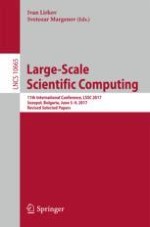This book constitutes the thoroughly refereed post-conference proceedings of the 11th International Conference on Large-Scale Scientific Computations, LSSC 2017, held in Sozopol, Bulgaria, in June 2017.
The 63 revised short papers together with 3 full papers presented were carefully reviewed and selected from 63 submissions.
The conference presents results from the following topics: Hierarchical, adaptive, domain decomposition and local refinement methods;Robust preconditioning algorithms;Monte Carlo methods and algorithms;Numerical linear algebra;Control and optimization;Parallel algorithms and performance analysis;Large-scale computations of environmental, biomedical and engineering problems.The chapter 'Parallel Aggregation Based on Compatible Weighted Matching for AMG' is available open access under a CC BY 4.0 license.
